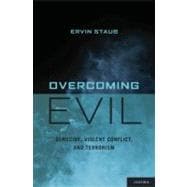
What is included with this book?
| Introduction: I. Origins, Prevention, Reconciliation | p. 3 |
| Introduction: II. Early and Late Prevention, the Costs of Violence, Evil and Goodness | p. 26 |
| The Origins of Mass Violence | |
| The Sources of Conflict between Groups and Primary Examples | p. 51 |
| Instigating Conditions: Starting Points of Mass Violence | p. 100 |
| Psychological and Societal/Group Processes That Arise from Instigating Conditions | p. 132 |
| Learning by Doing in Individuals and Groups: The Evolution of Extreme Violence | p. 166 |
| Internal and External Bystanders: Their Passivity, Complicity, and Role in the Evolution of Violence | p. 195 |
| Cultural/Societal Characteristics That Make Hostility and Violence More Likely | p. 208 |
| Perpetration and the Perpetrators | p. 239 |
| Understanding the Woundedness/Psychological Transformation of All Parties in Mass Violence | p. 274 |
| Prevention and Reconciliation | |
| Introduction and Late Prevention | p. 289 |
| Promoting Understanding, Healing, and Reconciliation in Rwanda | p. 300 |
| Constructive Responses to Difficult Life Conditions and Conflict, Preventive Diplomacy, and Dialogue | p. 309 |
| Developing Positive Orientation to the ôOtherö: Humanizing and Contact with the Other | p. 327 |
| Beyond ôUsö and ôThemö: Constructive Ideologies and Groups, Common Identities, Inclusive Caring, and Pluralism | p. 343 |
| Changing Hearts and Minds: Information, Peace Education, Deradicalization, and Public Education in Rwanda and the Congo | p. 362 |
| The Potential and Power of Active Bystanders: Citizens, Leaders, Nations, and the International System | p. 387 |
| Generating Constructive Action by Leaders and Citizens, Creating Structures for Prevention | p. 406 |
| Healing/Psychological Recovery and Reconciliation | p. 430 |
| Other Elements of Reconciliation: Complex Truth, Collective Memory, Shared History, and Justice | p. 442 |
| Forgiveness, Healing, and Reconciliation | p. 470 |
| Raising Inclusively Caring, Morally Courageous Children and Altruism Born of Suffering | p. 489 |
| Recommendations and Conclusions | p. 498 |
| References | p. 519 |
| Author Index | p. 551 |
| Subject Index | p. 561 |
| Table of Contents provided by Ingram. All Rights Reserved. |
The New copy of this book will include any supplemental materials advertised. Please check the title of the book to determine if it should include any access cards, study guides, lab manuals, CDs, etc.
The Used, Rental and eBook copies of this book are not guaranteed to include any supplemental materials. Typically, only the book itself is included. This is true even if the title states it includes any access cards, study guides, lab manuals, CDs, etc.